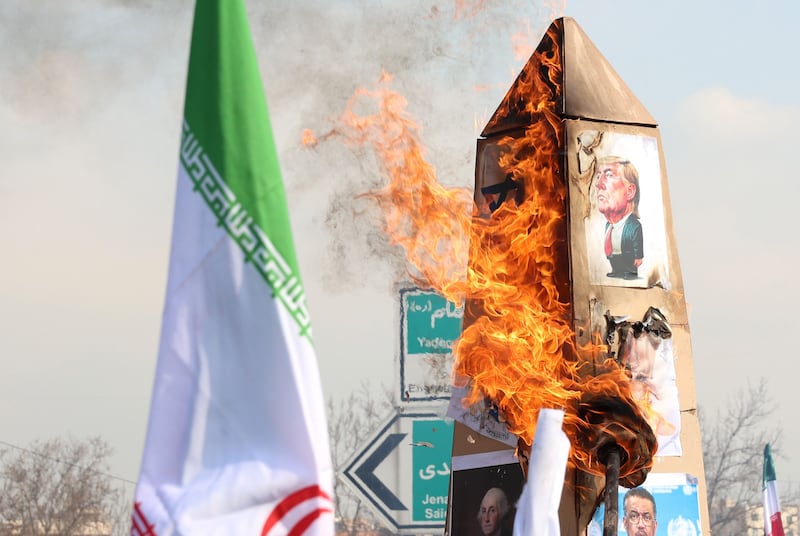In June 2023, as the full-scale invasion of Ukraine that Russian president Vladimir Putin had launched a year earlier was getting bogged down, one of Russia’s leading political scientists proposed a solution. Sergei Karaganov said Putin should make clear to the western powers that if they continued to arm and fund Kyiv, Moscow would use nuclear weapons against Nato member states.
Karaganov, a former adviser to Putin who remains close to the Kremlin, argued that the West’s decision to get involved in a full-scale war “in the underbelly of a nuclear superpower” showed that they did not believe Moscow would ever use a nuclear weapon. To restore the deterrence that endured throughout the cold war, Russia had to let Nato know that it was willing to use nuclear weapons pre-emptively.
“But what if they do not back down? What if they have lost the instinct of self-preservation completely? In this case we will have to hit a bunch of targets in a number of countries in order to bring those who have lost their mind to reason,” he wrote.
Putin has not taken up Karaganov’s grotesque proposal, although he has reminded the western powers that a direct confrontation between Nato and Russia could lead to nuclear war. The nuclear deterrent has been effective in persuading Nato not to deploy forces openly in Ukraine and not to attempt to enforce a no-fly zone over the country.
READ MORE
But as Ankit Panda argues in his important and timely book, nuclear deterrence has become increasingly frail and unstable. And as the old cold war contest between the US and Russia gives way to a three-way rivalry including China, almost all the multilateral mechanisms to control weapons and prevent nuclear conflict have fallen away.
Panda, a senior fellow in the Nuclear Policy Programme at the Carnegie Endowment for International Peace, is best known as an expert on North Korea’s nuclear policy. But while this book covers the threat posed by all nuclear-armed states, its primary focus is on the nuclear superpowers and the changing dynamic between them.
“Any nuclear use, anywhere, will have global consequences: from the potential climactic effects of nuclear winter leading to massive famine, to second- and third-order economic, political and social effects,” he writes.
“Maintaining the record of nuclear non-use since Nagasaki will be more challenging in a world of more players, more capable players in more places, new technologies and growing loose talk around nuclear war.”
An exploding nuclear weapon vaporises itself into a gas hotter than the core of the sun, creating a fireball of superheated air that can ignite fires and burn flesh more than 20 miles away from the explosion. Hiroshima survivors described melting eyeballs and flesh falling away from the bones like a sleeve after exposure to the thermal flash of the explosion.
People close to the flash can go blind, and radiation from the nuclear explosion damages cells in the human body, leading to long-term illness even among those farther away. The destruction of buildings causes further injuries and death and the more nuclear weapons are used in an attack, the greater will be the extent of radiation and its risks.
After the destruction wrought by the United States’ attacks on Hiroshima and Nagasaki in August 1945, it was clear that nuclear weapons could put an end to the human race. This danger became closer after the Soviet Union developed an atomic weapon and the cold war nuclear arms race began.
[ Hiroshima officials condemn nuclear deterrence ‘folly’Opens in new window ]
In 1959 Ireland put forward a resolution in the United Nations General Assembly calling on any state possessing nuclear weapons at the time to refrain from sharing that technology with non-nuclear states. This formed the basis for the Treaty on the Non-proliferation of Nuclear Weapons, which is, with 191 signatories, the world’s biggest and most successful arms control treaty.
After the near-catastrophe of the Cuban missile crisis in 1962, Washington and Moscow developed channels of communication aimed at avoiding an unwanted nuclear war. But the most effective deterrent against a nuclear conflict between the cold war superpowers was the doctrine of mutually assured destruction (MAD).
At the heart of this doctrine was the idea that if one country launched a full-scale nuclear attack on a country with the capacity to strike back with nuclear weapons, that would ensure the annihilation of both. Both the US and the Soviet Union had such second-strike capabilities, and MAD offered effective deterrence throughout the cold war.
The collapse of the Soviet Union marked the end of what Panda identifies as the first nuclear age, giving way at first to a period of optimism. The 1990s saw the acceleration of a process begun in the 1980s that saw big reductions in the huge nuclear arsenals built up by Washington and Moscow.
This second nuclear age saw advances in global nuclear governance with the parties to the treaty agreeing in 1995 to extend it indefinitely. And the five recognised nuclear-armed states – the US, Russia, China, France and Britain – pledged not to threaten non-nuclear states with a nuclear attack.
Four other states – India, Pakistan, Israel and North Korea – have nuclear weapons, and Iran is close to the threshold where it could develop them. The western powers reached an agreement with Iran that would allow it to develop civilian nuclear energy in return for verifiable steps away from its weapons programme but Donald Trump pulled the plug on it during his first term.
[ Trump calls for immediate nuclear talks with TehranOpens in new window ]
Trump engaged in serious negotiations with North Korea’s Kim Jong-un that could have led to nuclear disarmament but the US president walked out of a summit in Hanoi in 2019, collapsing the talks. Kim has shown no interest in a rapprochement with Washington since then and has abandoned Pyongyang’s aspiration to unite the Korean peninsula.
From the time it first tested a nuclear weapon in 1964, China adopted a different approach from the US and Russia, immediately announcing a “no-first-use” policy. It kept its nuclear arsenal small relative to the other great powers, with warheads numbered in the low 200s compared to the thousands deployed by Moscow and Washington.
Since Xi Jinping came to power, China has beefed up its nuclear forces, modernising its systems and increasing the number of warheads. Washington now faces the prospect of two nuclear peers in Moscow and Beijing but without the guardrails provided by big arms control agreements.
“Arms control and confidence-building measures designed to reduce the risk of unwanted war are an essential component of ensuring that humanity might continue to coexist uneasily with the bomb, and that the bomb might remain unused in war, as it has since 1945,” Panda writes.
He notes that the abandonment of nuclear agreements by the US and Russia has been accompanied by a growing confidence in Washington about the effectiveness of missile defence systems. The risk is that such systems could threaten the second strike capability of nuclear adversaries that has been a bedrock of deterrence.

Panda warns that the new nuclear age could see a three-way arms race between the US, Russia and China and a greater willingness to consider a “limited” use of nuclear weapons. And he expresses anxiety about the recklessness of some western political actors who are demanding that Nato call Russia’s nuclear bluff over Ukraine.
His book ends with a call for a rediscovery of arms control, which requires adversaries to acknowledge their shared interest in survival alongside the dangers of unbounded nuclear competition.
“This most fundamental condition does not exist at the heart of any of the big competitive nuclear relationships today but it can perhaps be created through the willingness of national leaders to take risks and muster the political will to reduce nuclear risks,” he writes. “Arms control has never been an act of altruism for one’s adversary. Rather, it is the pursuit of one’s own interests – in lowering the costs of an arms race, the consequences of deterrence failure and the risk of war in general – that should motivate this.”
Amid advances in the military and nuclear application of technologies such as AI, Panda says it is tempting to conclude that the problems facing arms control will be primarily technological. But he says the core obstacle to progress is political as it is difficult to persuade a domestic constituency of the virtue of restraint in the face of powerful adversaries.
He advocates the use of quieter, less public channels, noting that the details of the deal that resolved the Cuban missile crisis only became public years later. Trump is not known for quiet diplomacy but he has been audacious in seeking deals with America’s enemies, and the world should hope that this impulse is stronger in his second term.
Denis Staunton is China Correspondent
















